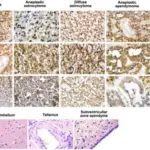
The morphology changes of glioma microvasculature along with the increase of the WHO grade.(A) thin-wall or sinusoid vessels with different sizes of lumen in grade II glioma, (B-C) irregular buds, cell cords and thick-wall vessels in some areas of grade III glioma, (D-H) strip cord, plexus, glomeruloid, ophidian microvessels in grade IV glioma and (I) more proliferation of heterotypical vessels found around necrotic and hemorrhagic areas in grade IV glioma. (HE A-G Bar = 100 um, H and I Bar = 200 um).Hyperplasia of pericytes is one of the main characteristics of microvascular architecture in malignant glioma.
Sun H, Guo D, Su Y, Yu D, Wang Q, Wang T, Zhou Q, Ran X, Zou Z - PloS one (2014). Not Altered. CC.
Gliomas originate in the glial cells that surround nerve cells. Three types of glial cells can produce tumors. Gliomas are classified according to the type of glial cell involved in the tumor, as well as the tumor’s genetic features, which can help predict how the tumor will behave over time and the treatments most likely to work.
Examples of gliomas include:
- Astrocytomas
- Oligodendrogliomas
- Ependymomas
- Paraventricular mass lesions
- Neuronal tumors



